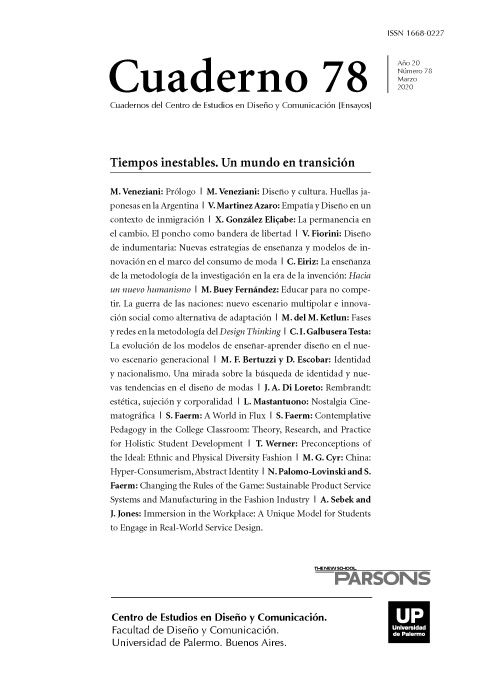China: Hyper-Consumerism, Abstract Identity
Résumé
Es el siglo 21 el siglo chino? La occidentalización ha cambiado casi todas las facetas de la vida en China, a excepción de la política (Wu, 2009). Esto ha creado confusión masiva, entusiasmo, rebelión, romanticismo e idealismo. Las industrias manufactureras de la década de 1990 continuaron dominando la aceleración del consumismo en el siglo XXI y crearon, más que nunca, un mundo de identidad extrañamente gigante y abstracto que se auto creó y se mantuvo. Este artículo examina la política del deseo abstracto, el hiper consumismo y la noción de fantasía en la industria de la moda china. Hoy, cientos de “hipermercados” gigantes que se encuentran en toda China están dedicados a la distribución de “cosas” falsas. Estos emblemas comerciales se han convertido en una parte integral del paisaje visual y social de China. El mercado de productos falsificados que utilizan imágenes de marcas occidentales (ej., logotipos) ha crecido durante siglos hasta convertirse en una gran estructura abstracta de estilos de vida con marcas falsas y diseño integral. El aumento global del hiperconsumo le dio a China la última oportunidad de crear una nueva identidad para sí misma mientras se importa el sueño del lujo: The Buying Power. Este documento se centra en abstraer la noción de hiperconsumismo e interrogar la relación entre la publicidad visual, su materialidad y su representación en el mercado global. ¿Cómo contribuye la publicidad a la producción de bienes de consumo? ¿Podemos crear una visión cíclica de nuevos materiales? ¿Cómo se crea, se desplaza, se transforma y se consume el valor del lujo a través del espacio y el tiempo?
Références
AFP. (2016, May 6). Gucci apologises over Hong Kong funeral fakes row. Hong Kong Free Press. Retrieved from https://www.hongkongfp.com/2016/05/06/gucci-apologises-hongkong-funeral-fakes-row/
Amed, I. (2014, May 5). Building Vogue China. The Business of Fashion. Retrieved from https://www.businessoffashion.com/articles/global-currents/building-vogue-china
Assandri, F. (2015). Supermarket of the dead: Burnt offerings in China & the cult of globalized consumption. W. Scheppe (Ed.). Cologne: Walther König.
Bain, M. (2017, June 4). The meteoric rise of Chinese consumerism will reshape the world, and maybe even destroy it. QUARTZ. Retrieved from https://qz.com/994345/the-meteoric-rise-of-chinese-consumerism-will-reshape-the-world-and-maybe-even-destroy-it/
Banta, A. (2017, November 10). Why Chinese consumers opt for luxury goods over travel experiences. Luxury Society. Retrieved from https://www.luxurysociety.com/en/articles/2017/11/do-consumers-prefer-luxury-goods-or-travel-experiences/
Baudrillard, J. (1968). The system of objects. Paris, France: Editions Gallimard.
Beam, C. (November 6). One man, 1.7 million square meters. New Republic. Retrieved from https://newrepublic.com/article/115463/worlds-largest-building-area-chinas-newcentury-global-center
Craciun, M. (2013). Material culture and authenticity: Fake branded fashion in Europe. London, UK: Bloomsbury Academic.
Crewe, L. (2017). The geographies of fashion: Consumption, space, and value. London, UK: Bloomsbury Press.
Cheung, A. (2017, February 12). How to reach the elusive Chinese millennial? [interview with Amed, I.] The Business of Fashion. Retrieved from https://www.youtube.com/watch?v=lOuRlamvjpo and https://www.businessoffashion.com/articles/voices-video/angelica-cheung-how-to-reach-the-elusive-chinese-millennial-consumer
Debord, G. (1967/1994). Society of the spectacle. (D. Nocholson-Smith, Trans.). London: Zone Books.
Douglas, M. & Isherwood, B. (1979). The world of goods: Towards an anthropology of consumption. London: Allen Lane.
Foucault, M. (1988). Technologies of the self: A seminar with Michel Foucault (1st ed.). L. H. Martin & H. Gutman (Eds.). Boston, MA: University of Massachusetts Press.
Fernandes, C. (2014, December 7). The history of knockoffs in China. Conquer China. Retrieved from http://www.conquer-china.com/land-knockoffs-can-china-innovate/
Gruendl, H. & EOOS. (2007). The death of fashion: The passage rite of fashion in the show window. New York, NY: Springer Vienna Architecture.
Jolas, M. (1958/1994). The poetics of space: The classic look at how we experience intimate places. (G. Bachelard, Trans.). Boston, MA: Beacon Press.
Julier, G. (2017). Economies of design. London, UK: Sage.
Koolhass R. & Hoster, H. (2013). Junkspace with running room. London, UK: Notting Hill Editions.
Larousse. (2018). Paris, France: Larousse Incorporated. Retrieved from www.larousse.fr
Lin, G. (2016, April 28). Dead serious: Gucci warns afterlife paper offering shops over copyright. Hong Kong Free Press. Retrieved from https://www.hongkongfp.com/2016/04/28/dead-serious-gucci-warns-afterlife-offering-shops-over-copyright/
The Merriam-Webster Dictionary New Edition. (2016). Springfield, MA: Merriam-Webster Incorporated.
Pasha-Robinson, L. (2018, January 23). China bans hip-hop culture and tattoos from all media sources. Independent. Retrieved from http://www.independent.co.uk/news/world/asia/china-hip-hop-ban-tattoos-media-tv-newspapers-radio-film-a8174501.html
Rearick, L. (2018, January 24). China bans hip-hop culture, tattoos from television. Teen Vogue. Retrieved from https://www.teenvogue.com/story/china-bans-hip-hop-culturetattoos-tv
Simmel, G. (1957). Fashion. The American Journal of Sociology, 62(6), 541-558.
Simpson, C. (2017, September 28). Luxury back in Vogue as China's middle class women lead the way. The Business of Fashion. Retrieved from https://www.businessoffashion.com/articles/news-analysis/luxury-back-in-vogue-as-chinas-middle-class-women-lead-the-way
Tsui, C. (2016, September 1). Top fashion schools in China: Pushing forward despite philosophical divide. The Business of Fashion. Retrieved from https://www.businessoffashion.com/articles/education/top-fashion-schools-in-china-2
Van Bogaert, P., Zoeteman, M., & Coppens, C. (Eds.). (2017). Eternal erasure - on fashion matters. Berlin: Sternberg Press.
Wang, X. (2015). Inauthentic authenticity: Semiotic design and globalization in the margins of China. Semiotica, 203, 227-248.
Wu, J. (2009). Chinese fashion: From Mao to now. Oxford, UK: Berg Publishers.
Zhen, L. (2017, September 21). Fame academy, the Chinese college offering classes in how to become an internet celebrity. South China Morning Post. Retrieved from http://www.scmp.com/news/china/society/article/2112252/fame-academy-chinese-college-offeringclasses-how-become-internet
Los autores/as que publiquen en esta revista ceden los derechos de autor y de publicación a "Cuadernos del Centro de Estudios de Diseño y Comunicación", Aceptando el registro de su trabajo bajo una licencia de atribución de Creative Commons, que permite a terceros utilizar lo publicado siempre que de el crédito pertinente a los autores y a esta revista.


